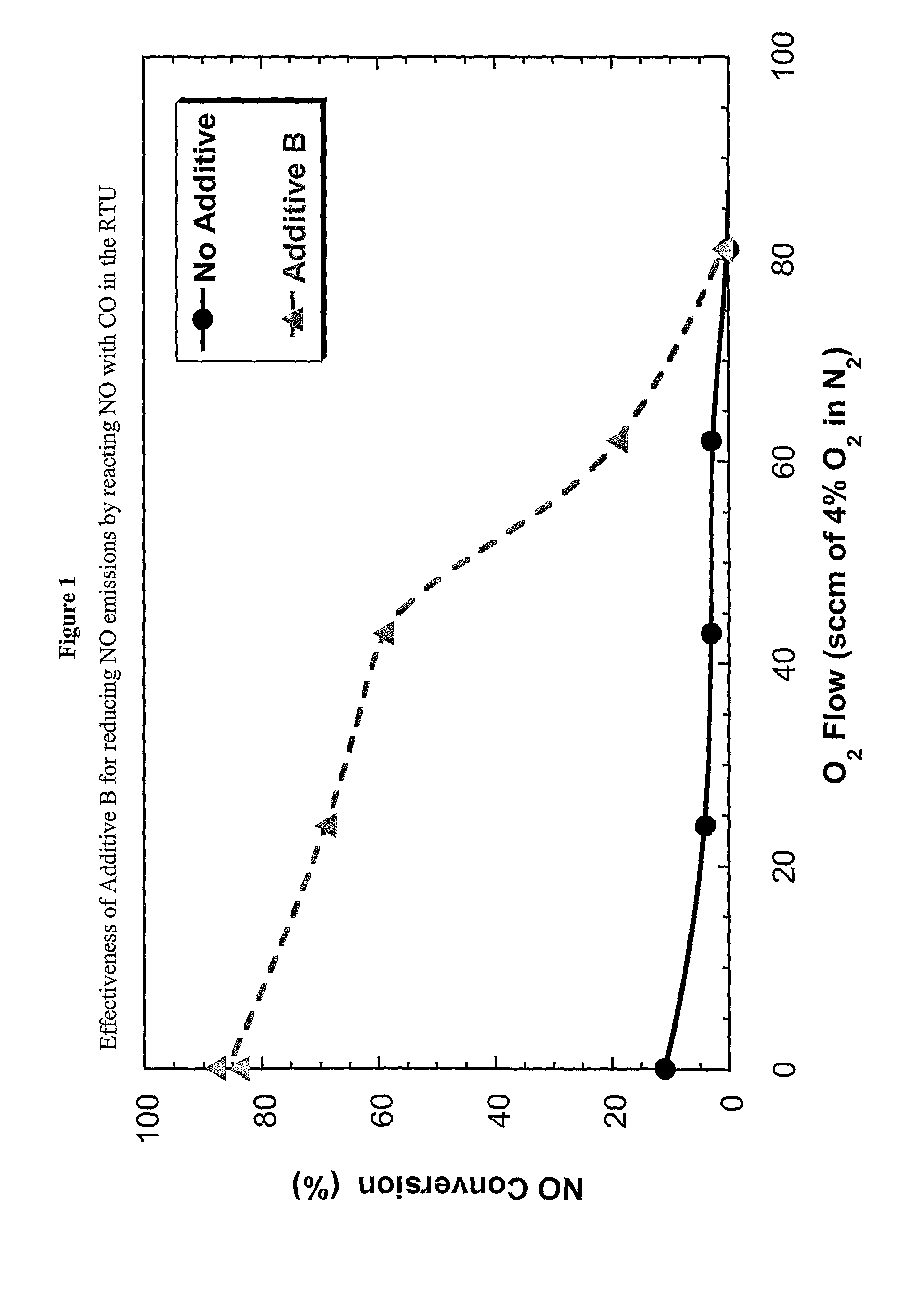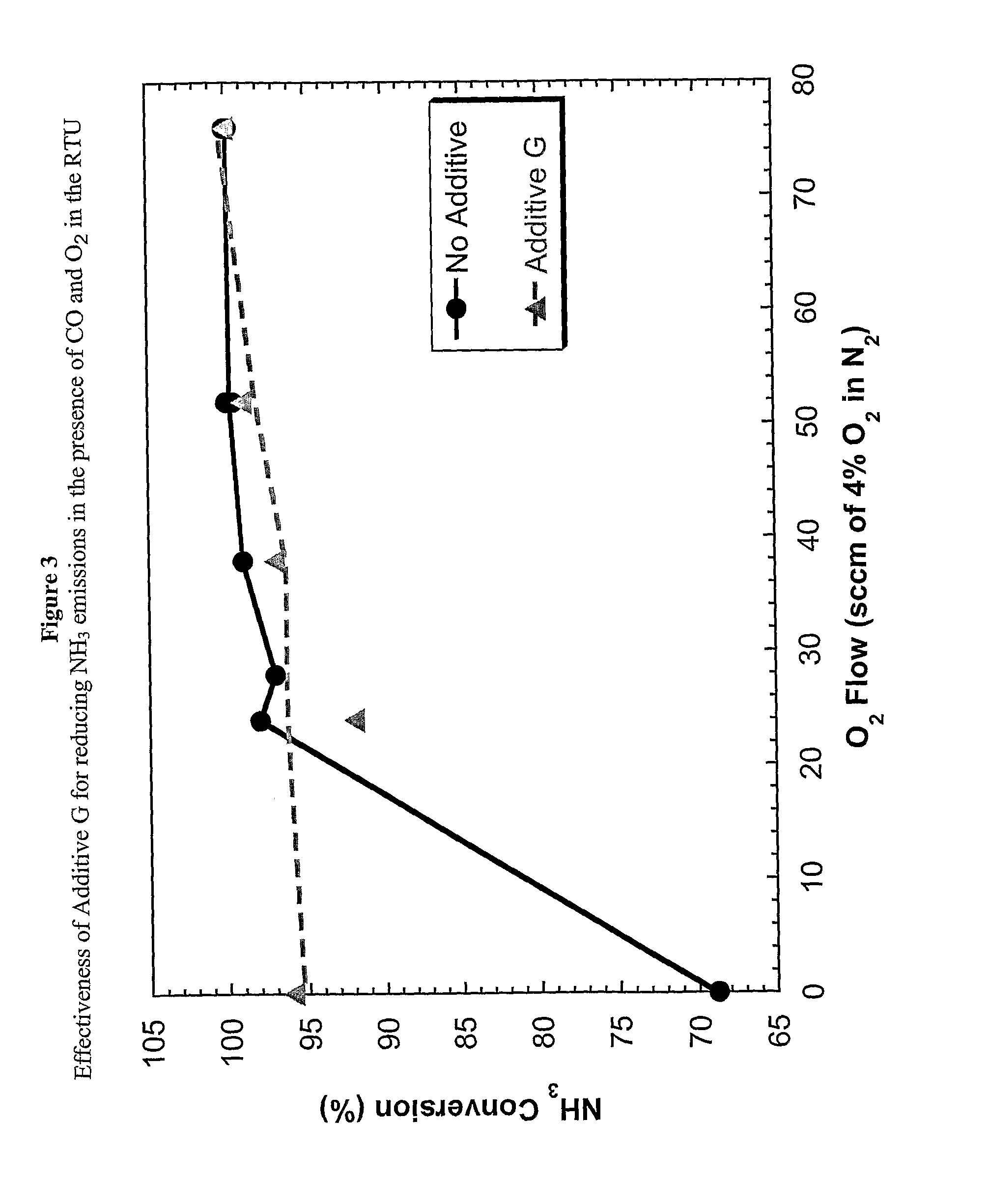Method for Controlling Nox Emissions in the Fccu
a technology of nox and nox, which is applied in the direction of physical/chemical process catalysts, metal/metal-oxide/metal-hydroxide catalysts, and separation processes, etc. it can solve the problems of nox present, not enough oxygen to convert/burn all reduced species regardless, and not enough to all. , to achieve the effect of reducing nox present, reducing nox, and oxidizing reduced nitrogen species
- Summary
- Abstract
- Description
- Claims
- Application Information
AI Technical Summary
Benefits of technology
Problems solved by technology
Method used
Image
Examples
example 1
[0096]Ferrierite zeolite was exchanged with copper ions using a solid-state exchange procedure as follows: Copper chloride (120 grams, dry basis) was ground into a fine powder and then blended with 1800 g of ferrierite powder. The blend was calcined for 4 hours at 325° C. The calcined blend was slurried with 9000 g of water maintained at 80° C., stirred for 10 minutes and then filtered. The filtercake was washed three times with 80° C. water, dried at 100° C. for 10 hours and then calcined at 593° C. for 1.5 hours. The finished product contained 2.3% Cu.
[0097]A composition comprising 65% of the Cu-exchanged ferrierite, 15% clay and 20% alumina sol was prepared by forming an aqueous slurry containing 1522 g of aluminum chlorohydrol solution (23% solids), 1138 g (dry basis) of the Cu-exchanged ferrierite and additional water in an amount sufficient to make a slurry containing about 40% solids. The slurry was milled in a Drais mill to an average particle size of less than 2.5 μm and th...
example 2
[0098]The activity of Additive A for reducing NO emissions from an FCC unit was assessed by using the Davison Circulating Riser (DCR). The DCR has been described in G. W. Young, G. D. Weatherbee, and S. W. Davey, “Simulating commercial FCCU yields with the Davison Circulating Riser (DCR) pilot plant unit,” National Petroleum Refiners Association (NPRA) Paper AM88-52; and in G. W. Young, “Realistic Assessment of FCC Catalyst Performance in the Laboratory,” in Fluid Catalytic Cracking: Science and Technology, J. S. Magee and M. M. Mitchell, Jr. Eds., Studies in Surface Science and Catalysis, Volume 76, p. 257, Elsevier Science Publishers B.V., Amsterdam 1993, ISBN 0-444-89037-8, which description is herein incorporated by reference.
[0099]In this experiment, the DCR was operated at “full burn” conditions, that is with 1% excess O2 in the regenerator, and with the regenerator operating at 705° C. The DCR was initially charged with a blend of 1895.25 g of an equilibrium cracking catalyst...
example 3
[0101]A microspheroidal particulate support material was prepared as follows: A slurry was prepared from an aqueous slurry having 20% solids of a peptizable alumina (Versal 700 alumina powder obtained from La Roche Industries Inc., 99% Al2O3, 30% moisture). The alumina slurry was prepared using 31.6 lbs of the alumina. To the alumina slurry 3.87 lbs of an aqueous sodium hydroxide solution (50% NaOH) was added. Then, 10.4 lbs of cerium carbonate crystals (obtained from Rhone Poulenc, Inc., 96% CeO2, 4% La2O3, 50% moisture) was added to the slurry. The slurry was diluted with a sufficient amount of water to bring the solids concentration at 12%. Finally, 3.38 lbs of exchanged silica sol of Nalco 1140 (obtained from Nalco Chemicals Co.) was added to the slurry. The mixture was agitated to assure good mixing and then milled in a stirred media mill to reduce agglomerates to substantially less than 10 microns. The milled slurry was fed to a 10 ft diameter Bowen Engineering spray drier to ...
PUM
| Property | Measurement | Unit |
|---|---|---|
| mean particle size | aaaaa | aaaaa |
| pore size | aaaaa | aaaaa |
| molar ratio | aaaaa | aaaaa |
Abstract
Description
Claims
Application Information
 Login to View More
Login to View More - R&D
- Intellectual Property
- Life Sciences
- Materials
- Tech Scout
- Unparalleled Data Quality
- Higher Quality Content
- 60% Fewer Hallucinations
Browse by: Latest US Patents, China's latest patents, Technical Efficacy Thesaurus, Application Domain, Technology Topic, Popular Technical Reports.
© 2025 PatSnap. All rights reserved.Legal|Privacy policy|Modern Slavery Act Transparency Statement|Sitemap|About US| Contact US: help@patsnap.com



